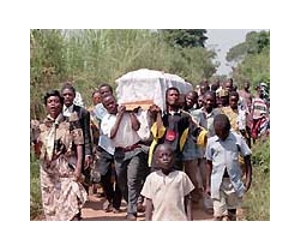7,000 people a day still catching AIDS: UN
by Staff Writers
United Nations (AFP) June 3, 2011
 |
About 7,000 people are being infected with AIDS each day and about half of the 34 million people with HIV do not know they have it, according to a UN report released to mark the disease's 30th anniversary.
The UNAIDS agency said more money, less waste and smarter programs are urgently needed to consolidate gains made in the war on AIDS and HIV.
The report highlighted spectacular progress made in the 30 years since US epidemiologists, in a study released on June 5, 1981, described the cases of five young homosexuals whose immune systems had been destroyed.
But UNAIDS said that about 34 million people were living with HIV at the end of 2010 and that nearly 30 million people have died from Acquired Immune Deficiency Syndrome, or AIDS, in the past three decades.
The rate of new infections of human immunodeficiency virus (HIV) that causes AIDS has declined. But the UN agency said "the total number of HIV infections remains high at about 7,000 per day."
UNAIDS also estimates that about half of those with HIV do not know they are sufferers.
"It is a major problem, it is a major, major major issue," said Michel Sidibe, the executive director of UNAIDS at the launch of the "AIDS at 30: Nations at the Crossroads" report.
Sidibe said the worrying figures proved the need for wider scale testing that would reduce the infection rate.
"The number of people becoming infected and dying is decreasing, but the international resources needed to sustain this progress have declined for the first time in 10 years, despite tremendous unmet needs," UN Secretary General Ban Ki-moon warned in the report which comes ahead of an AIDS summit at the UN headquarters next week.
"We have a long way to go to prevent new HIV infections, end discrimination and scale up treatment, care and support," he said.
UNAIDS painted a tableau of early setbacks and later successes in the fight against a complex disease.
It hailed in particular "dramatic gains" in getting AIDS drugs -- once the preserve of rich economies -- to patients in poor countries.
At the end of 2010, 6.6 million people in low- and middle-income countries had access to treatment, it said.
This amounted to an increase of 1.4 million over 2009, and a 22-fold rise over 2001, "a vivid illustration of the power of international solidarity, innovative approaches and people-centered responses."
On the downside, the global tally still fell far short of the goal of "universal access" that the United Nations had enshrined for 2010. That deadline came and went with another nine million badly-infected people still in need of treatment.
Achieving that aim and tackling the many other issues of AIDS will require a major boost in funds, UNAIDS warned.
Between 2001 and 2009, resources for poorer countries rose 10-fold, from 1.6 billion dollars annually to 15.9 billion.
But this rise masks a flatlining that began with the 2008 financial crisis as western countries that are overwhelmingly the biggest foreign contributors began to tighten their belts.
The United States alone accounted for 3.165 billion dollars in AIDS support in 2009, followed by Britain, with 658 million and the Netherlands with 389 million dollars, although Denmark donated most as a percentage of its GDP.
"Waning support" had to be reversed, said the report.
The report also pointed the finger at countries that were doing too little to prevent new infections, or failing to spend money in ways that would have the greatest impact.
Former US president Bill Clinton, a veteran AIDS campaigner, said the fight against AIDS had to adjust to leaner times by being less wasteful.
NGOs had to cut overheads, governments had to reduce costs and efforts had to be focused on population niches most at risk of infection, he said.
Overall, the rate of new HIV infections has decline by about 25 percent over the past decade, the report said.
India has the highest number people living with HIV in Asia and South Africa has the highest number in Africa. But in India the rate of new infections has fallen by 50 percent over the decade and in South Africa by more than 35 percent.









No comments